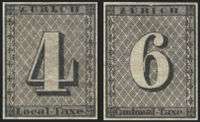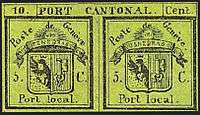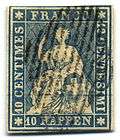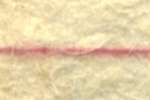Postage stamps and postal history of Switzerland

This is a survey of the postage stamps and postal history of Switzerland.
Cantonal issues
The first stamps used in Switzerland were issued by the cantons of Zürich, Geneva and Basel for their own use, with the first federal issues coming several years later.
Zürich

The Zurich 4 and 6 was first put on sale 1 March 1843, making it the second type of stamp in the world, after the UK's Penny Black three years earlier. The issue consisted of two imperforate stamps printed separately, each in five types, in sheets of 100, one with a large numeral "4" and the other with a "6", both inscribed "Zürich" at the top. The 4-rappen stamp was also inscribed "LOCAL-TAXE" at the bottom, since it was intended to pay for letters mailed within a city, while the 6-rappen, inscribed "CANTONAL-TAXE", was for use with letters going anywhere in the canton. The design was lithographed in black by Orell, Fuessli, and Company, with a pattern of fine red lines underneath, to discourage counterfeiting. Initially the red line were vertical, but starting in 1846 they were printed horizontal. These stamps were popular from the start, but were not printed in large numbers and are quite scarce today, with values ranging from US$1,500 to $20,000 depending on type.
Canton Zurich also issued a stamp in 1850, known to collectors as the Winterthur issue, depicting the Swiss federal cross and a posthorn, which served as a transitional issue until the stamps of the Swiss federal government made their appearance later that same year.
Geneva

Geneva brought out its own stamp issue on 1 October 1843, the "Double Geneva". Like the first Zürich issue, it consisted of pairs of stamps, each printed in black on yellow-green paper, depicting the city's arms, and inscribed "Poste de Genéve" at the top and "Port local" at the bottom. But an additional inscription, reading "10 PORT CANTONAL Cent" ran across the top of each pair. The idea was that the user could cut out a single stamp to pay the intra-commune rate, and a pair to make up the inter-commune rate. Only 6,000 of the doubles were ever printed, and as of 2008, intact used doubles typically go for around US$60,000 at auction.
In 1845, Geneva switched to conventional single 5c stamps. In 1849 it printed a 4c stamp featuring the federal cross in black and red, and similar 5c designs in 1850 and 1851.
Basel

Basel only ever issued one stamp, the "Basel Dove" of 1845. This was a 2½-rappen value featuring a white embossed dove carrying a letter in its beak, and inscribed "STADT POST BASEL", a design by the architect Melchior Berry. It is printed in black, crimson, and blue, making it the world's first tri-colored stamp.
Federal issues
Local mail and rayon stamps

The adoption of the federal constitution in 1848 made it practical to issue confederation-wide stamps, and the first of these came out in 1850 (the exact date is uncertain). All used the same basic design, a Swiss cross surmounted by a posthorn, but there were a number of variations. The local-rate stamps had a value of 2½ rappen, with some inscribed "ORTS-POST" (German) and "POSTE LOCALE" (French). This was the first of many multi-language issues. For longer-distance mail, the 5-rappen stamp was inscribed "RAYON" and the 10-rappen, "RAYON II". Initially the stamps were issued with a black frame separating the white cross from the red background, but as a technically incorrect rendition of the Swiss arms, these were withdrawn.
In 1852 a 15-rappen/centime value inscribed "RAYON III" was issued, using the same design as previously, but printed entirely in vermilion.
Helvetias

All of the preceding issues were declared invalid on 1 October 1854, and replaced with the seated allegorical figure "Helvetia", the first of several issues known as "seated Helvetias". The figure was embossed but only the outline was colored, making it rather hard to pick out. This was the first issue to deal with the multiple languages of Switzerland; in addition to the word "FRANCO" at the top, the other three sides listed the denomination in rappen, centimes, and (Italian) centesimi.
The issue was also notable for the use of a colored silk thread running horizontally through the paper, as an anti-counterfeiting measure. (In the illustration to the left, the thread is faintly visible about 1/3 of the distance from the bottom of the stamp, looking almost like a crease.)

A number of values were printed between 1854 and 1862, ranging from 5 rappen to 1 franc, and philatelists distinguish them further by type of paper and color of thread. The commonest type surviving today is the 5-rappen brown on thick paper with a green thread, costing US$20 used; certain other types are rare, and the pale yellow-green shade of the 40-rappen value will go for $7,000 or more.
A new design with more legible seated Helvetia appeared in 1862, now sporting a "watermark" consisting of a cross inside an ellipse (not a true watermark because it was impressed into the paper after printing), and for the first time, perforations. The units of currency disappeared, with "HELVETIA" inscribed at the top and "FRANCO" at the bottom. Initially printed on white wove paper, the stamps switched to granite paper in 1881. (The paper has red and blue silk threads, clearly visible in the larger image of the stamp to the left.) The stamps continued in use until 1883; many of them are common and cheaply available today, although legitimate cancellations on the granite paper varieties are uncommon because of the short period of use.

In 1882, the low value stamps (up to 15c) were numerals, while the higher values featured a "Standing Helvetia". These continued in use, with a number of variations in color, perforation, and paper, until 1907. 1900 saw Switzerland's first commemorative stamps, a set of three values issued for the 25th anniversary of the Universal Postal Union, with an allegorical design featuring various symbols of communication.
20th century
A new definitive series in 1907 showed William Tell's son holding a crossbow and an apple pierced by an arrow for values below 10c, a bust of Helvetia for 10c to 15c values, and another seated Helvetia for higher values. The William Tell's son design went through several redrawings, including a temporary move of the bowstring in front of the crossbow's stock. From 1914 on, a portrait of William Tell himself was used for values between 10c and 30c.
Also in 1914, the first of many scenic stamps were issued. The 5fr depicted the Rütli meadow, while the 3fr and 10fr stamps showed the Mythen and Jungfrau mountains, respectively.
The first semi-postal stamp was issued in 1913, but regular annual issues did not start until 1915. For many years an issue of 3-5 stamps came out on 1 December each year, until 1972.
An set of three stamps in 1919 celebrated peace at the end of World War I. Stamp printing experienced some difficulties during this period, and a variety of surcharges were needed in 1915 and 1921. The UPU was noted on its 50th anniversary in 1924 with two stamps, one depicting its building in Bern and the other the location of the 1874 Congress.
In about 1930 Switzerland began to use "grilled gum", a light grill applied along the gum to counteract the tendency for gummed stamps to curl. The grill is most obvious on mint stamps, but is faintly visible on used stamps as well. This was abandoned around 1944.
The next definitive series was a set of scenic views issued in 1934. The designs were typographed, resulting in a vigorous albeit somewhat crude-looking appearance, and they were superseded by engraved versions of the same basic designs, beginning in 1936.
Several commemorative issues appeared in the 1930s, then in 1941 came new definitives honoring Swiss military heroes. Another definitive set in 1945 marked the end of the war; the higher values of this were issued in small numbers, and are relatively expensive today.
The definitive series of 1949 depicted achievements of Swiss technology. Since that time, Swiss stamps have generally followed a regular pattern; an issue of about four commemoratives on a single date in the spring, and a similar group in the fall, as well as a Europa issue, usually in the spring. Starting in the 1980s, there have been additional themed issues; for instance, in 1993 an issue of four stamps featured works of art by Swiss women.
See also
Bibliography
Postal history
- Keller, Max. Stempel aus der Stadt Bern zwischen 1803 und 1850. Erlach: Philatelistenverein Bern, 2010, 78p.
- Schäfer, Richard. Handbuch Postgeschichte von Genf: Anfänge bis 1854 = Histoire postale de Genève. Waldstetten: Just-prephilately, 2006, 276p.
- Schäfer, Richard. Das Postwesen der alten Eidgenossenschaft: Anfänge bis 1798 = Swiss postal history of the old Confederation = Histoire postale de l'ancienne Confédération. Reinach: Multipress Verlag, 2000, 418p.
Cantonal issues
- Bach, Jean-Paul and Felix Winterstein. Basler Taube. Reinach: Multipress, 1995 ISBN 3-9520837-2-0, 148p.
- Gnagi, Jakob. Die Zurcher Kantonalmarken von 1843. Bern: Organisationskomitee der NABA ZURI 84, mit Unterstutzung durch den Fonds zur Forderung der Philatelie, 1984, 113p.
- Reuterskiold, Axel de, Baron. Les timbres cantonaux de la Suisse et leurs falsifications. Lausanne: Societe Lausannoise de Timbrologie, 1898, 51p.
General issues
- Hall, Richard T. Philately of Switzerland: an introductory handbook. Asheville, N.C.: American Helvetia Philatelic Society, 2010 ISBN 0984431705, 345p.
- Hermann, Urs. Sitzende Helvetia Ungezähnt = Les Rappen (1854-1863). Wettingen: Strubel-Literatur, 2006 2 vols.
- Mirabaud, Paul and Alex de Reuterskiöld. The postage stamps of Switzerland, 1843-1862. Lawrence, MA.: Quarterman Publications, 1975, 266p.
- Zinsmeister, Marian Carne. Switzerland, 1850-1958: detailed information concerning the stamps of Switzerland, when, why, and how issued. Lemont, Pa.: Society of Philatelic Americans, 1959, 80p.
- Zumstein. Katalog Schweiz/Liechtenstein, Campione und Vereinte Nationen, Genf = Catalogue Suisse/Liechtenstein, Campione et Nations Unies, Genève. Annual.
International organisations
- International Labour Office. Postage stamps and the International Labour Organisation. Genèva: International Labour Office, 1965, 15p.
- Misteli, Charles. Study on the postal stamps and cancellations of the League of Nations, the International Labor Office and their international conferences. Pasadena, CA.: United Nations Philatelists, Inc., 1995, 72p.
External links
| Wikimedia Commons has media related to Stamps of Switzerland. |